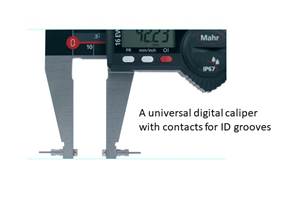Surface Texture From Ra to Rz
The irregularity of a machined surface is the result of the machining process, including the choice of tool; feed and speed of the tool; machine geometry; and environmental conditions. This irregularity consists of high and low spots machined into a surface by the tool bit or a grinding wheel.
Share




The irregularity of a machined surface is the result of the machining process, including the choice of tool; feed and speed of the tool; machine geometry; and environmental conditions. This irregularity consists of high and low spots machined into a surface by the tool bit or a grinding wheel. These peaks and valleys can be measured and used to define the condition and sometimes the performance of the surface. There are more than 100 ways to measure a surface and analyze the results, but the most common measurement of the mark made by the tool, or the surface texture, is the roughness measurement.
It is not uncommon for different parties involved in the production to use different methods for roughness measurement. In this column we will talk about only two of the many methods of roughness measurement, how to convert between these two methods, and how to avoid the problems caused by the inevitable use of more than one roughness measurement.
In North America, the most common parameter for surface texture is Average Roughness (Ra). Ra is calculated by an algorithm that measures the average length between the peaks and valleys and the deviation from the mean line on the entire surface within the sampling length. Ra averages all peaks and valleys of the roughness profile and then neutralizes the few outlying points so that the extreme points have no significant impact on the final results. It's a simple and effective method for monitoring surface texture and ensuring consistency in measurement of multiple surfaces.
In Europe, the more common parameter for roughness is Mean Roughness depth (Rz). Rz is calculated by measuring the vertical distance from the highest peak to the lowest valley within five sampling lengths, then averaging these distances. Rz averages only the five highest peaks and the five deepest valleys—therefore extremes have a much greater influence on the final value. Over the years the method of calculating Rz has changed, but the symbol Rz has not. As a result, there are three different Rz calculations still in use, and it is very important to know which calculation is being defined before making the measurement.
In today's global economy, machined parts are being made and shipped around the world. As a result, manufacturing and quality control engineers are often forced to decide whether or not to accept a part when the print requirements are not consistent with measurement on the surface gages in the local facility. Some quality control engineers might even assume that if a part is checked and passed using the parameter available, the part would also pass other checks. In these cases, the engineers are assuming a constant correlation, or ratio, exists between different parameters.
If there were no choice but to accept some assumptions, there are rules of thumb that can help clear up the confusion and convert Ra to Rz or Rz to Ra. If the manufacturer specifies and accepts the Rz parameter, but the customer uses the Ra parameter, using a ratio range for Rz-to-Ra = 4-to-1 to 7-to-1 is a safe conversion. However, if Ra is used as an acceptance criteria by the manufacturer, but the customer accepts Rz to evaluate the part, then the conversion ratio would be much higher than 7-to-1, possibly as high as 20-to-1. Keep in mind that the actual shape of the part's profile will have a significant impact on these ratios.
Communication at the outset of the project can avoid most surprises. The approximate, and sometimes questionable, comparisons can be avoided by developing an understanding of exactly what a parameter on a print means, and how the various parties involved in the production plan to check surface texture. The best way for those involved in the production to be in agreement on the parameters for measurement is to have capable evaluation equipment in both the manufacturer's and customer's facility, making the same check using the same method. If the manufacturer or the customer uses conversion ratios, then both parties should be aware of the use of the ratio and be comfortable with the ramifications.
Related Content
Choosing the Correct Gage Type for Groove Inspection
Grooves play a critical functional role for seal rings and retainer rings, so good gaging practices are a must.
Read MoreTurning Fixed-Body Plug Gages Inside Out
Fixed-body mechanical plug gages provide fast, high-performance measurement for tight-tolerance holes.
Read MoreRethink Quality Control to Increase Productivity, Decrease Scrap
Verifying parts is essential to documenting quality, and there are a few best practices that can make the quality control process more efficient.
Read MoreThe Link Between CNC Process Control and Powertrain Warranties
Ever since inventing the touch-trigger probe in 1972, Sir David McMurtry and his company Renishaw have been focused on achieving process control over its own manufacturing operations. That journey has had sweeping consequences for manufacturing at large.
Read MoreRead Next
Registration Now Open for the Precision Machining Technology Show (PMTS) 2025
The precision machining industry’s premier event returns to Cleveland, OH, April 1-3.
Read MoreSetting Up the Building Blocks for a Digital Factory
Woodward Inc. spent over a year developing an API to connect machines to its digital factory. Caron Engineering’s MiConnect has cut most of this process while also granting the shop greater access to machine information.
Read MoreBuilding Out a Foundation for Student Machinists
Autodesk and Haas have teamed up to produce an introductory course for students that covers the basics of CAD, CAM and CNC while providing them with a portfolio part.
Read More.png;maxWidth=970;quality=90)
















.png;maxWidth=300;quality=90)















